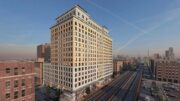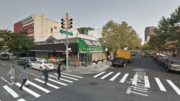The New York City Economic Development Corporation (NYCEDC) has released preliminary plans, ahead of a presentation set to be given later in September, to develop a 1.1-million-square-foot mixed-use project at 2460 Second Avenue, in northern East Harlem. The city-owned property, currently a vacant 105,000-square-foot former bus depot, was the site of a church and a slave burial ground during the 17th century, Commercial Observer reported. The redevelopment would include a 15,000-square-foot living memorial and cultural center in honor those who were buried there. The rest of the project could include 730 rental apartments, half of which would rent at below-market rates. In addition, the plan calls for 315,000 square feet of commercial space, including retail and offices, and 30,000 square feet for community facilities. It would be accommodated by a 300-car parking garage and 18,000 square feet of outdoor space. Since the site is city-owned, the project must be approved through the Uniform Land Use Review Procedure (ULURP). Completion is tentatively set for 2022. The block-encompassing site is located between East 126th and 127th streets.
Subscribe to the YIMBY newsletter for weekly updates on New York’s top projects
Subscribe to YIMBY’s daily e-mail
Follow YIMBYgram for real-time photo updates
Like YIMBY on Facebook
Follow YIMBY’s Twitter for the latest in YIMBYnews






Take a bow to burial ground, following 730 rental apartments that project choose and through the busy plans. (commercial)
More than that, the building is over 100 years old and was originally a car barn for the trolley system.
That Bus Terminal used to be William Randolph Hearst’s Cosmopolitan Studios that was destroyed by a fire in 1923. 25 feature films were filmed them.
The reason the TriBoro Bridge jogs north instead of a more logical entrance at 96th St was partially due to this building and inspired Robert Caro to write “The Power Broker”…
“Why am I so interested in political power? Because in a democracy, political power shapes all our lives. You can see this in simple, small, relatively insignificant things. Robert Moses… agreed to put the Manhattan terminus of the Triborough Bridge at 125th Street instead of 96th Street, as had been planned and as was more convenient and logical, because William Randolph Hearst, the influential publisher, owned real estate on 125th Street and he wanted it condemned for the bridge. Every time you drive twenty-nine blocks out of your way to get to the Triborough Bridge your life is being affected–in a small way, of course–by political power as exercised by Robert Moses.”